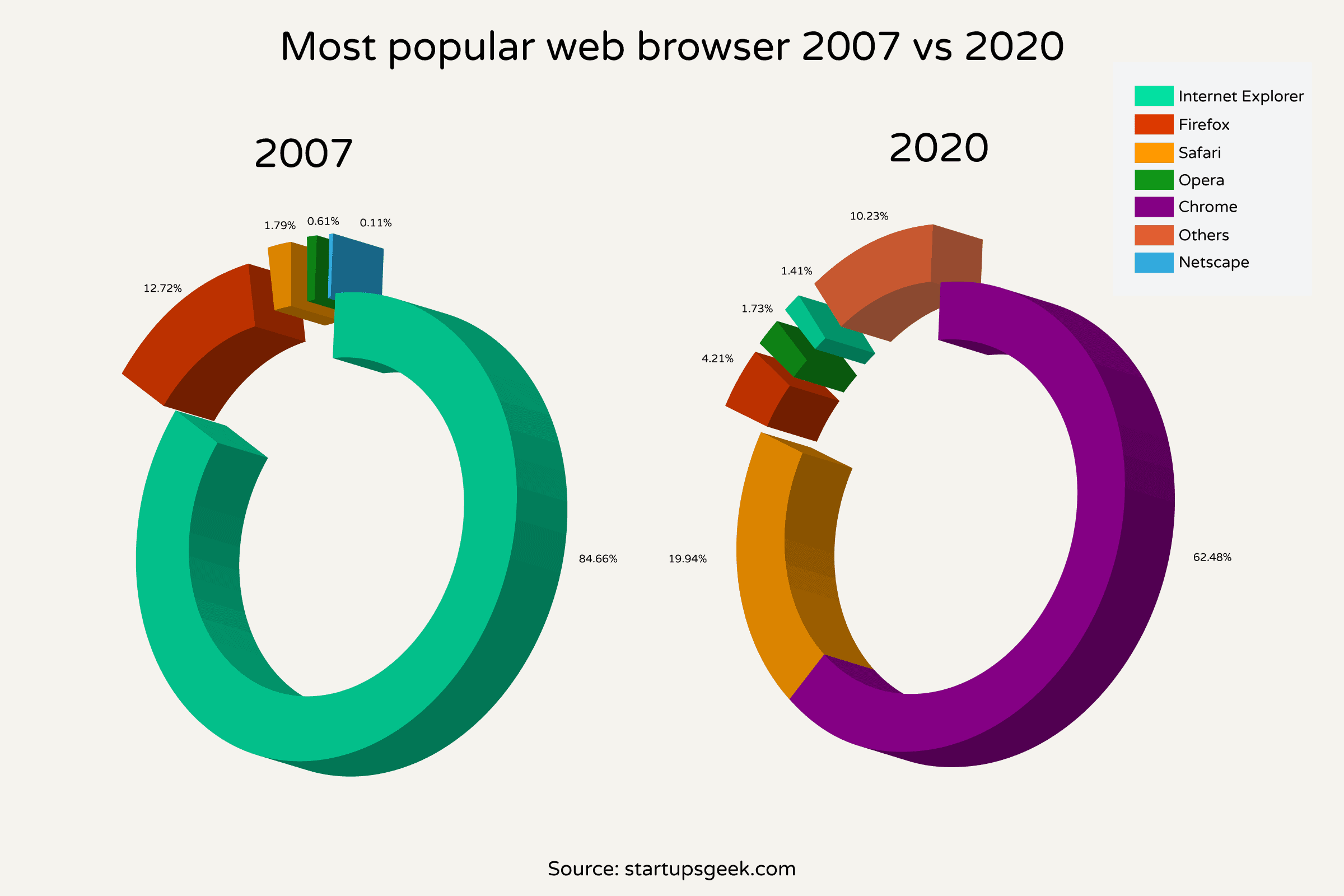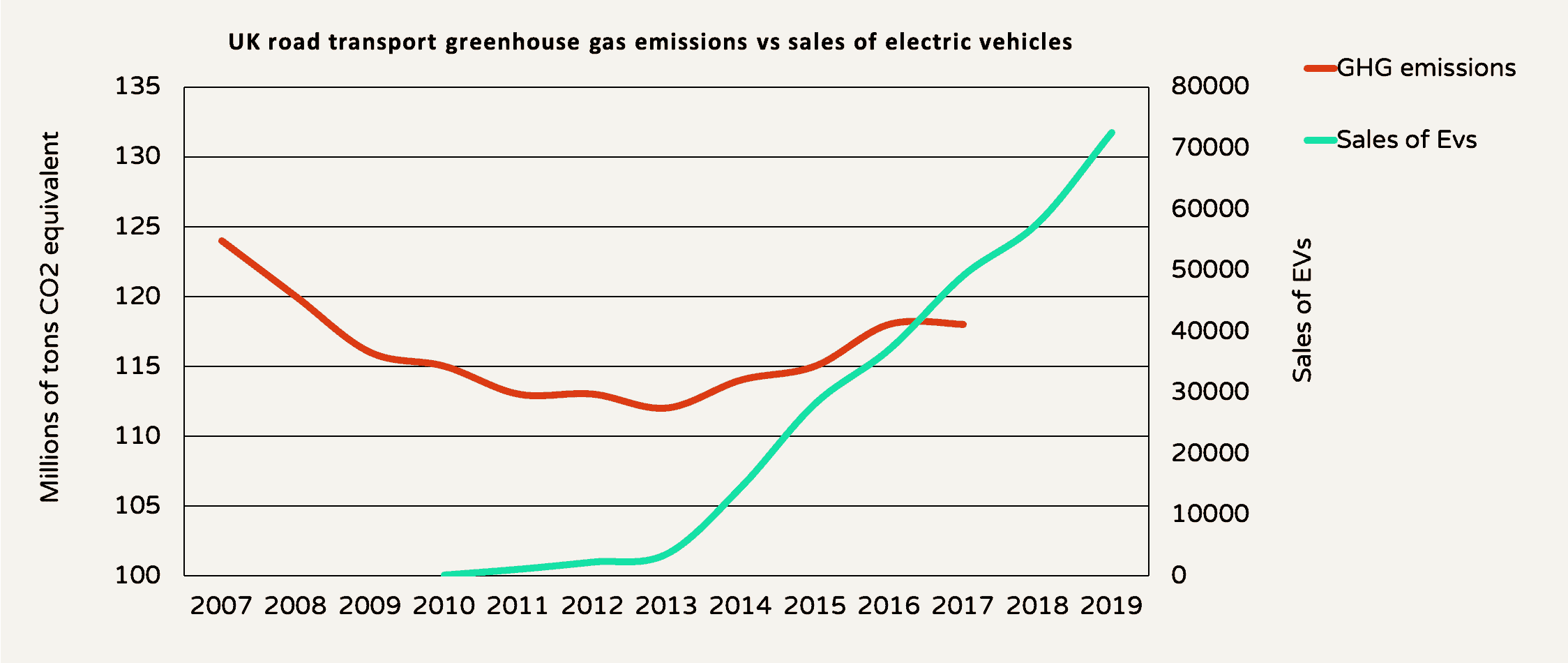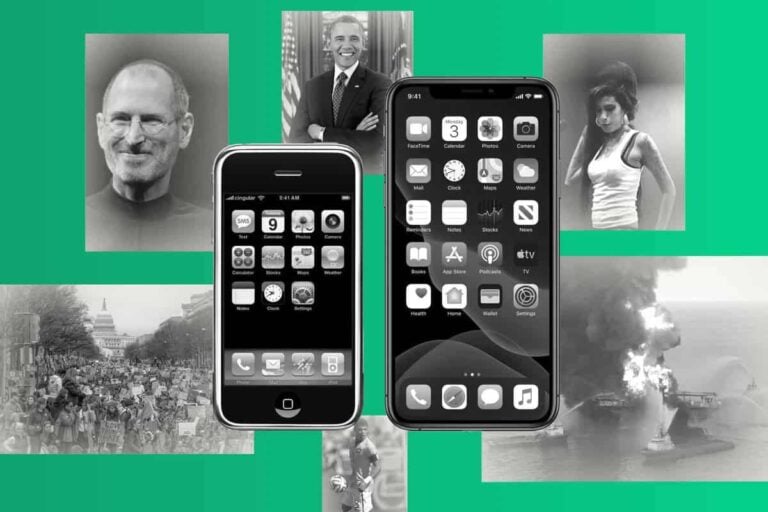On the 29th of June 2007 the iPhone was released by Apple, and the world had never seen anything quite like it. It ushered in the age of portable tech and the smartphone era was born.
Since then the world has changed in unimaginable ways, and Apple has not only been part of the change, but also one of the driving forces of change.
The technology landscape back in 2007 looked very different than today:
- YouTube was only two years old
- 22% of online searches were still made on Yahoo!
- MySpace was the biggest social network and was worth $12 billion
- Facebook had only 20 million users (which might sound a lot, but is only 1% of its user base today)
- £7.4 billion worth of paper cheques were spent on retail in the UK
Table of contents
Infographic: cultural shift in the smartphone era
Skip to bottom ↓
1. The demise of Internet Explorer
Back to contents ↑
When the iPhone was launched, browsing the internet was something you did on a desktop and Internet Explorer(IE) had nearly 85% of the market. The iPhone started the move to mobile, with Safari the only option on the first iPhone.
Windows were slow to adapt to this change and the Windows phone, which launched in 2010 could not break the hegemony of iOS and Android and was shelved in 2016.
Google Chrome hadn’t even been released back in 2007, and today it’s by far the most popular browser with almost two thirds of the market, with IE falling to 1.41%.
Mobile browsing has grown prodigiously, and mobile-only browsers account for a not insignificant share of the market. For instance Samsung Internet Browser has 3.28% of the share.

2. The rise of mobile browsing
Back to contents ↑
122 million smartphones were sold in 2007; now there are 2.7 billion smartphone users in the world. We now access the internet in a completely different way than when the iPhone was first released.
In 2007 only 61% of UK households had access to the internet and Starbucks didn’t have free wifi. That number had risen to 93% by 2019 and free wifi is ubiquitous in cafes and shops.
In 2010 fewer than half of us accessed the internet on our phones, but by 2019 100% of 16-24 year olds and 40% of over 65s had access to the internet on their phones.
[visualizer id=”19378″ lazy=”no” class=””]3. Dwindling circulation of newspapers
Back to contents ↑
The iPhone allowed the internet to become more integrated into our lives, and this has had a massive effect on traditional media outlets.
For example, in 2007 the Sun newspaper’s circulation was over 3.2 million, but today that number has dropped by more than 2 million. Its 40 years as the nation’s favourite newspaper was eclipsed by the Metro in 2018.
In line with falling circulation, ad spend in print has dropped significantly. In 2008 nearly a third of ad spend in the UK was on print, by 2018 that had dropped to 11%.
We now engage with media online, with 57% of digital media usage on mobile apps in 2017.
4. Ad spend in mobile eclipses desktop
Back to contents ↑
The iPhone has revolutionised where ad spend is spent. When the iPhone was released only 16% of UK ad spend was online. By 2018 this had risen to 57% with an online ad spend of £13,439 billion in the UK, the third largest in the world.
As mobile browsing has increased so has mobile ad spend, which passed desktop ad spend in 2017. With over 50% of browsing the internet happening on phones, global mobile-ad spend was projected to be $165.7 billion in 2019.
Unsurprisingly the two big players in the UK market are Google and Facebook who control over 62% of the online digital market.
[visualizer id=”19588″ lazy=”no” class=””]5. UK number one e-commerce country
Back to contents ↑
In 2007 only 3.4% of retail sales were online, this has been steadily growing and now accounts for 26.2%. The iPhone has driven that growth, as now more than 50% of online shopping happens on mobile.
The UK spends more online per capita than any other country. The average person spends £3,041 online each year and 91% of internet users buy online.
Purchasing penetration is high in those under the age of 65, but there is still room for growth for those over 65 as only 54% of them purchased something online in the previous year.
[visualizer id=”19461″ lazy=”no” class=””]6. App revenues
Back to contents ↑
When the iPhone was launched there was a notable absence from it: the App Store. It wasn’t released until a year later in 2008 with only 500 apps, yet 10 million apps were downloaded over its first weekend.
By creating this market they have helped usher in the smartphone era. There is an app for every imaginable thing, and app numbers on both the App Store and Google Play (Android) now number in the millions.
App revenues, generated via paid downloads, in-app advertising and purchases, were $4 billion in 2009.
In 2018 revenues had climbed to $365 billion and are expected to reach a staggering $935 billion by 2023. Interestingly 90% of apps are free on the App Store but they account for 98% of revenues.
China makes up nearly 40% of global app revenue. Arena of Valor was the top earning mobile game in 2019; it made a jaw-dropping $1.43 billion.
[visualizer id=”19490″ lazy=”no” class=””]7. The growth of social media
Back to contents ↑
The iPhone allowed us to update our social media on the go. Long gone are the days of having to sit at a computer to post something on the internet.
The iPhone allowed a proliferation in social media users. Now one third of the world is on Facebook. Facebook has been able to grow its revenues by allowing advertisers to target its users. In 2007 its revenues were $153 million, in 2019 that had risen to $70.6 billion of which 98.5% was from advertising.
Twitter’s revenue in 2019 was $3.46 billion, Instagram generated $14 billion and YouTube brought in $15.1 billion for Google.
[visualizer id=”20822″ lazy=”no” class=””]8. UK largest percentage of music streamers
Back to contents ↑
The iPhone allowed us to take music with us, without needing another device to play music on. Since that time digital music sales from subscriptions and mp3 downloads have increased dramatically. In 2019 the UK spent over £1 billion on streaming services like Spotify and Amazon.
There were a 114 billion songs streamed in the UK in 2019, a 3,000% increase on 2012. The UK is the most popular streaming country, 83% of us listened to streamed content last year.
9. The rise of on-demand video
Back to contents ↑
When the iPhone came out the UK spent £1,581 billion on DVDs, but this dropped to £477 million in 2019.
Not only has the DVD market changed, now the average age of a BBC One viewer is 60 and we watch nearly an hour less of live TV than we did a decade ago. The reason for this is the growth of streaming on demand sites like YouTube, BBC iPlayer, Netflix and Amazon Prime.
Netflix has the most subscription video-on-demand (SVOD) users, with over 13 million. Amazon Prime Video has 7.9 million subscribers and Disney+ has had over 4 million subscribers since its launch in March this year.
31 million of us watched a video on a mobile device last year, market penetration is high, with only those over 65 not using mobile regularly.
10. A complete shift in how we take digital photos
Back to contents ↑
The iPhone wasn’t the first phone to house a camera, but it helped drive the development of digital spaces where we share and communicate with photos.
In 2007 50 billion digital photos were taken and digital camera sales peaked at 121.5 million in 2010. Since then digital camera sales have dropped by 87% and the number of digital photos taken in 2020 grew to a staggering 1.42 trillion. That’s 4.5 million photos a second.
Phones and tablets account for nearly 92% of those photos.
11. Tech companies dominating
Back to contents ↑
When the iPhone was launched the ten biggest companies in the world comprised mainly of oil, telecommunications and financial services companies. The only tech company on the list was Microsoft.
Apple entered the top 10 in 2009 and became the biggest company in 2012. The dawning of the smartphone era, has completely changed the look of the ten biggest companies. Now the top 7 companies in the world are tech companies.
On the 2nd of September this year Apple was worth £1.7 trillion which is more than all the companies on the FTSE 100.
12. Impact on in-car technology
Back to contents ↑
As car-makers are increasingly moving towards the development of electric vehicles, they’ve been focusing more on in-car user experience and touch-screen dashboard technology for internet-enabled cars.
In 2014 Apple released the first version of Apple CarPlay, allowing iPhone users for the first time to connect their digital worlds more seamlessly while travelling.
Vehicle miles have increased by over 4% since 2007, but greenhouse gas (GHG) emissions from road transport has dropped 5% as cars become more efficient.
GHG emissions from road transport have not been falling as quickly as the rest of GHG emissions, they now make up one fifth of all GHG emissions, up from one sixth in 2007.
There is a huge opportunity to bring these numbers down quickly if the UK can move towards electric vehicles (EV).
EV sales have grown rapidly from just 138 in 2010 to 72,584 in 2019. However they still only account for 3.4% of total car sales in the UK.
As this market grows and with the growth in cycling we could see a transformation in our cities and a fall GHG emissions.

13. Takeaway Britain
Back to contents ↑
There has been a 34% increase in the number of takeaway restaurants in the UK since 2010. Apps account for 39% of takeaway and fast food deliveries.
The delivery company uses their app for the whole process, from picking up the order, to navigating to your house to dropping it off. The takeaway market was worth £8.5 billion in 2019 and is expected to grow to £9.8 billion by 2021.
The UK eats around 5kg more of meat a year than it did a decade ago. Poultry is the most consumed meat from takeaways.
Although our meat-eating habits have increased slightly, so have the number of vegans. It was estimated that 0.3% of population were vegan in 2007, that number has grown to over 1%.
[visualizer id=”19545″ lazy=”no” class=””]
